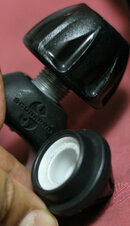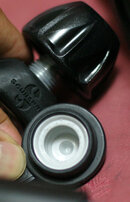Some dust caps seal very well and others do not.
If a dust cap of the solid rubber variety gets weather checked or takes a set that prevents a perfect seal it will leak. If a dust cap of the hard plastic variety with an o-ring loses the o-ring, it will leak. A leaking plug on the reg will result in water getting inside and will damage the reg.
So...as a general rule, install the dust cap and then test it for leaks by inhaling as hard as you can through one of the second stages. If you get any air you either have a leak in the second stage diaphragm, exhaust valve or one of the o-rings that seals the case - or you have a leak in the dust cap of the first stage. You'll be able to hear where the leak is at (first or second stage)so in addition to testing the dust cap it is a good test of second stage condition as well.
Obviously if you have a leak in the dust cap that you can't resolve, don't rinse the reg.
Ideally, if you have the option, leave your gear assembled and rinse it with a fresh water hose at the dock, then soak it when you get home. A short dunk in an increasingly salty rinse tank does not do much good. If you have a small pony, pressurize the reg at home and rinse it and soak it in the bathtub. When soaking warm water does a better job of removing salt deposits. If you do not have a pony soak it anyway, but ensure the dust cap is tightly sealed.
A few companies have from time to time used a system where the second stage releases pressure on the seat to prevent engraving of the seat during storage. The approach has significant downsides as it leaves the system open not only to water during rinsing, but also to any creepy crawlies that may find the reg during storage. They are generally not a great idea as they fix a non existant problem. Annual replacement of the seat prevents any leaks from storage induced seat engraving and the create more complexity in the second stage with additional parts and o-rings.
In my opinion, a fairly clean quarry IS a great big rinse tank. If the water is clear you can see the halocline form around you when you get in.






